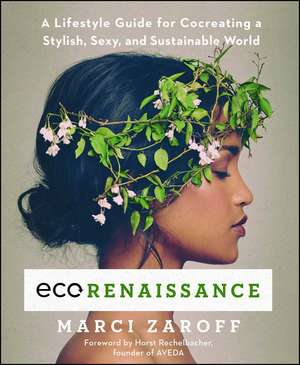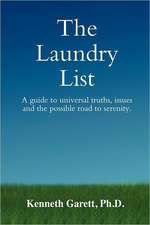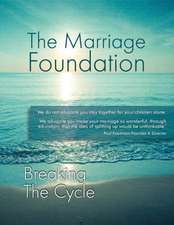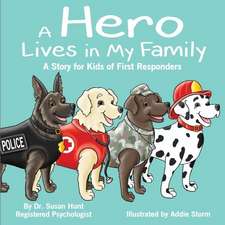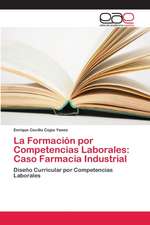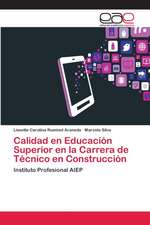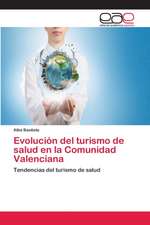ECOrenaissance: A Lifestyle Guide for Cocreating a Stylish, Sexy, and Sustainable World
Autor Marci Zaroff Cuvânt înainte de Horst Rechelbacheren Limba Engleză Paperback – 23 aug 2018
Gone are the days of boxy hemp shirts and gritty granola—cutting-edge innovation has made ecology as stylish and sexy as red carpet fashion, and everyday people are leading the charge with the choices they make in grocery stores, car lots, at work, in schools, and in their homes. In ECOrenaissance, renowned visionary Marci Zaroff provides a comprehensive guide to help you embrace sustainable living as both a celebration of style and a necessary strategy for maintaining our everyday comforts despite increasingly limited resources.
From global warming to drought, genetically modified foods to harmful chemicals in our beauty products, for too long commerce has ignored the health of our planet and our bodies. But now a new age is dawning: one that is uplifting, gorgeous, and accessible. With roundtable discussions from inspiring leaders of the green movement, ECOrenaissance offers you eye-opening and groundbreaking resources to transform your life through supporting companies making significant, practical ecological change.
By shining a light on leaders of sustainability throughout the world, Zaroff will transform your understanding of eco-minded products and open new possibilities for you to make a positive impact. Equipped with these tools, you will find new, empowering ways to make “green” elegant in your life, prioritizing current global needs without sacrificing comfort.
Preț: 101.68 lei
Nou
Puncte Express: 153
Preț estimativ în valută:
19.46€ • 20.19$ • 16.26£
19.46€ • 20.19$ • 16.26£
Carte disponibilă
Livrare economică 22 februarie-08 martie
Preluare comenzi: 021 569.72.76
Specificații
ISBN-13: 9781501123566
ISBN-10: 1501123564
Pagini: 272
Ilustrații: 47 b-w images throughout
Dimensiuni: 187 x 232 x 18 mm
Greutate: 0.46 kg
Editura: Atria/Enliven Books
Colecția Atria/Enliven Books
ISBN-10: 1501123564
Pagini: 272
Ilustrații: 47 b-w images throughout
Dimensiuni: 187 x 232 x 18 mm
Greutate: 0.46 kg
Editura: Atria/Enliven Books
Colecția Atria/Enliven Books
Notă biografică
Marci Zaroff coined the term and pioneered the market for “ECOfashion” and is an internationally recognized ECOlifestyle entrepreneur, educator, and expert who keynotes globally on organic/sustainable textiles, strategic creative vision, social innovation, green business/design, and the rise of the millennial generation. Marci is the founder and CEO of MetaWear Organic, founder of Under the Canopy, producer of THREAD | Driving Fashion Forward, and co-founder of the Institute for Integrative Nutrition, Good Catch Foods, and BeyondBrands. Zaroff is frequently featured in major TV and print media, including Newsweek, The New York Times, USA TODAY, InStyle, Lucky, Bloomberg, ELLE, Vanity Fair, CNN, E! Entertainment Television, the Discovery Channel, and many more. Find out more at MarciZaroff.com.
Extras
ECOrenaissance
![]()
The journey of a thousand miles begins with one step.
—LAO TZU
Not too long ago, I used to have to drive an hour to find the closest health food store or yoga class. The green lifestyle movement was confined to a small, niche community, dismissed by most as crazy hippies and granola-lovers.
While I don’t deny my inner tree-hugger, I’m also very much a material girl. I love fashion, travel, and delicious food, and I live in a high-rise in Manhattan. I wasn’t raised in a commune, ashram, or a yurt. And I don’t grow my own food or climb trees (although it probably would be good for me). So how did I get here?
My journey down the Green Brick Road was a combination of synchronicity and my unquenchable search for more—ideas, innovations, and solutions. It was never about leaving anything behind—it was always about yes, and. Looking and feeling fabulous shouldn’t come at the expense of living in harmony with the environment—surely I couldn’t be the only one who thought this. When I was starting out, though, style and ecology were seen as two dichotomous worlds.
I sought out fashion companies that were forward-thinking, but everything I came across was crunchy, frumpy, boxy, beige, and boring. I drove hours to find organic produce, but the health food stores of the time were limited and cramped. I knew that “green” would never become mainstream if it involved this much sacrifice.
I felt a deep calling to be part of the solution. If I could take people on a journey where ecology looks, tastes, and feels amazing, I could change the world for the better. I always knew, in my gut, that an ECOrenaissance wasn’t an if, it was a when.
Just over two decades later, I watch in amazement as the world of sustainability continues to transform before my eyes. Once empty environmental business conferences are now sold out. Huge corporations such as Walmart, Costco, and Target are selling more organic produce than Whole Foods, with Amazon now joining the party. Major celebrities are turning the red carpet green with glamorous ECOfashion. CVS and Duane Reade are lining their shelves with natural and organic personal care and beauty products. There is now a widespread acceptance and demand for gorgeous and green.
It’s a completely different world, and every single day I wake up and feel like I’m living my dream. And this is just the beginning.
My Journey
Looking back, my journey into the world of ecology and consciousness seems serendipitous. Although I grew up in a sheltered environment in then-rural South Florida (not exactly an eco-centric community), I always hungered for more, for deeper purpose and fulfillment in life. So when inspiration came knocking, I was ready to answer the door.
My initial breakthrough moment came at the age of fifteen. While shopping in the local mall, I encountered a beautiful, somewhat mystical twenty-one-year-old woman named Surya. We struck up a conversation, and there was an inexplicable connection between us, as if we had known each other all our lives. As synchronicity would have it, she worked as a new hairdresser at the salon I had been going to for years. I booked my next appointment with her, and what would follow was a lifelong friendship and mentorship.
Our conversations, delving into everything from food to relationships to spirituality, inspired Surya to offer me one of the most important gifts I’d ever receive, Shakti Gawain’s Living in the Light. This powerful book struck a profound chord—that there is something more than what we can physically see, so we must listen to and trust our gut, the lifeline to truth. In her book, Shakti states, “Every time you don’t follow your inner guidance, you feel a loss of energy, loss of power, a sense of spiritual deadness.”1 This book helped to illuminate the lightbulb within my heart and soul, shining as my compass for the journey ahead.
Surya and I are forever connected. I still remember the day she introduced me to AVEDA clove shampoo, cooked me my first organic plant-based meal, and stood upside down beside me as we learned yoga handstands (before yoga was a widespread concept!). We were in our own little world, our green bubble. And together, we explored and discovered. Every step we took was like opening a new door to an exciting playground of learning and self-discovery.
In 1990, the next auspicious force in my life happened while dining at a macrobiotic restaurant in New York City. While sitting at Ozu on the Upper West Side, I saw a man walk in the door who I thought resembled the renowned artist Peter Max. I was introduced to Peter’s art at the age of fifteen, about the same time I met Surya. Betsi, my childhood best friend, had a stepfather who collaborated with Peter at Woodstock and displayed several pieces of his art in their home. I remember how I was drawn to Peter’s messaging of “Love,” “Peace,” and “A Better World,” so I began to research his work. The themes in Peter’s artwork reflected his life as an environmentalist, vegan, and defender of human and animal rights. He created (and still does) with compassion and purpose, infusing environmental and social commentary into the canvas. I often think of MAX as a modern-day Michelangelo or Da Vinci, using art as a voice for change, a visual journal on the current environmental, political, and societal makeup. Max paints with love and purpose, the elements of ECOrenaissance art.
That day at Ozu, Peter saw me looking at him and asked if he could join me for lunch. I was thrilled. Here was someone whose art had influenced me for years, driving me further toward a creative and conscious lifestyle. And now there he was standing before me, in my favorite restaurant, asking to sit with me. Pinching myself, we explored ideas over tempeh, kale, and hijiki.
In 1990, inspired by Gulliver’s Travels, I had conceived of starting a holistic health school called Gulliver’s Living & Learning Center—dedicated to taking people on a journey to the lands of health, environmental wellness, and self-realization. As I shared my vision with Peter, he immediately responded by offering his support. He designed my first logo and business card for the school. And his art appeared on the cover and launch issue of our magazine, Macrocosm, where I interviewed him about his lifestyle philosophies and commitment to human and planetary consciousness.
Over the years, while cocreating the school and its professional certification program with my partner Joshua Rosenthal, Peter was a consistent friend and ally of our efforts. In fact, I still have a colorful piece of signed MAX art hanging in my New York apartment, with the tagline “Peace by the Year 2000.” More than twenty-five years later, Peter and I are still connected. And the school—today known as the Institute for Integrative Nutrition—is the world’s largest nutrition school, with more than 75,000 people now certified as “health coaches,” and with an online certification program offered in more than 130 countries around the world. The seeds planted years ago have now manifested into a bountiful and magnificent harvest.
At twenty years old (the same year I met Peter Max), I found a mentor figure in the late Horst Rechelbacher, the brilliant founder and CEO of AVEDA. Surya had introduced me to AVEDA and its philosophy of drawing from plant wisdom to revolutionize hair and body care products. This was at a time when functional beauty products were an absolute bath of chemicals, and when nature and mainstream beauty were at complete odds; AVEDA was breaking major ground. When I met Horst at a (lightly attended) environmental conference, I again experienced the kind of instant connection that had drawn me so fiercely to Surya and Peter.
Quickly, Horst became a guiding light in my life. He was using business as a force for good, and it resonated deeply with me. I’d been attracted to the business world all my life, and I wanted my entrepreneurial instincts to coincide with my more “out there” interests that I had explored and developed with Surya. Horst was living proof that modalities such as Eastern thought, plant intelligence, and indigenous philosophy could actually form the foundation for a wildly successful company, allowing him to share radical wisdom with consumers on their own terms. AVEDA is and was aesthetically packaged in a way that drew people in. Horst realized that educating people about the environment starts with great design, a concept that is at the core of this book.
Horst was an entrepreneurial leader, an artist, and a revolutionary, and his vision drove me further toward my own. It was a meeting of the minds like I’d never experienced before. We understood each other—we effortlessly spoke each other’s language and could seamlessly exchange ideas.
Around the same time that Horst decided to expand AVEDA outside of Minneapolis, I was in New York searching for a space for my school, which was gaining ground and had outgrown my apartment. Horst came to help me find the school’s first home, and with his support and foresight I found the perfect location. Recognizing the interconnection of the lifestyle dots between healthy food and holistic body care, we opened AVEDA’s first concept salon in New York—in my school.
Serendipitously, the web of Surya, Horst, and Peter created a powerful ripple effect as we inspired and encouraged one another and those around us. Surya, as a licensed hairdresser and talented chef, moved to New York and ran our school’s AVEDA spa, as well as many of our organic/natural food, cooking, and beauty classes. Peter, Horst, and I shared numerous organic meals in the early years of New York’s blossoming health food scene. Horst created AVEDA’s first New York Institute, in which I was an environmental and health educator. And most “coincidentally” (I don’t believe in coincidences), Horst’s daughter Nicole designed one of the nation’s first stylish organic clothing collections, Anatomy.
These bright lights around me—Horst, Peter, and Surya—acted as torches, further illuminating my individual path. As my personal beliefs and values converged with my professional world, I was able to have even greater clarity as to my true purpose. And I was drawn to other people who were undertaking the same work. When I was starting out, these people were few and far between, and we were living in our own universe. But I felt like we were planting seeds and cultivating them everywhere we went. And now, we’re watching them grow. From a few free spirits, a new movement is under way, propelling a new era for humankind.
Living Life Under the Canopy
What became evident in my early years of embracing health and wellness, and its relationship to all living beings, is that we all reside together “under the canopy” of our planet’s ecosystem. According to Native American philosophical traditions, the “canopy” is our ozone layer, protecting life and future generations. And the canopy also refers to the top layer of the rain forest, which produces much of the oxygen that human life needs to thrive.
As I deepened my knowledge of agriculture and the environment, I learned about the extensive relationships among the foods we eat, the animals with which we coexist, and exactly how our consumerism impacts the planet on which we live. I had an epiphany when I connected the dots between food and fiber, and learned that these ecosystems were truly interdependent. Hearing others refer to cotton as the world’s “dirtiest crop,” I became aware of the magnitude of cotton’s effects on the environment, as one of the most heavily sprayed agricultural crops on earth. And I was surprised to discover that 60 percent of a cotton plant enters into our food stream. Given my familiarity with food and wellness, I knew how effective developing an organic movement could be for personal and environmental health.
At the same time I was unearthing all this information about conventional cotton products, a series of events transpired that I can only interpret as fate. In 1994, I was surprised to receive a call from the assistant of HRH Sarah Bint Khalid, Princess of Saudi Arabia. At the time I was fully immersed in the programs and workshops we offered at Gulliver’s.
Princess Sarah and her sister-in-law Princess Hussa, who traveled to New York quite regularly, felt the buzz around Gulliver’s, as Princess Sarah was interested in learning about the ways an eco-lifestyle could improve her fertility. She hadn’t been able to get pregnant, although she had been trying for many years. Then somebody in her life suggested that if she changed her diet and lifestyle, it might help her to have a child. Her assistant searched for the best person to guide her, and ended up stumbling on Gulliver’s. I started consulting with Princess Sarah, and ultimately her improved choices around diet and wellness resulted in the first of several healthy pregnancies.
Suddenly her cousins and sisters also reached out to me, curious about how they could use lifestyle changes to lose weight, improve their skin, and mitigate adverse health conditions. It was a little surreal—I became an overnight health guru to countless Saudi Arabian princesses. I had my network of natural food chefs cooking for them, bringing them fresh plant-based food, both domestically and in Saudi Arabia (Surya lived in Princess Hussa’s palace for a year!). I was exporting organic foods as well as AVEDA and Jurlique beauty products to Saudi Arabia and other destinations in which they resided. I still to this day, more than two decades later, enjoy my friendship and consulting relationship with Princess Sarah, who now has three beautiful children.
Aside from guiding the princesses in the areas of health, we also had a fabulous time together shopping in New York. One day, we were shopping on Fifth Avenue, and Princess Sarah remarked, “You’ve turned us on to all these other products. You’ve changed our lifestyles. What about fashion?” At that point, the vague concept of organic and sustainable fashion had been marinating for some time, thanks to inspiration from Deja Shoes and my partnership with Anthony Rodale and the Rodale Institute—pioneers of the regenerative organic agricultural movement. But at that moment, everything fell into place, and a major lightbulb went off. I asked, “If I create styles made responsibly, will you buy them from me?” Their response was so enthusiastic, and within days I filed a trademark on “ECOfashion” and rolled my sleeves up, determined to fuse ecology with fashion. Shortly after, in 1996, I founded a direct-to-consumer sustainable lifestyle brand called Under the Canopy—the first of its kind.
Under the Canopy has always had a mission to give consumers what they seek in terms of style and comfort, without compromising environmental wellness or human rights. I have always been committed to breaking the stigma that you have to give up something to get social and environmental accountability—the worlds of style and substance are not mutually exclusive.
Under the Canopy was my first platform to revolutionize the fashion industry—through education, inspiration, collaboration, and innovation. Like Surya with wellness, Horst with beauty, and Peter with art, fashion became my vehicle to effect positive change. Although I didn’t go to fashion school and never learned the technical language, I’ve enjoyed an intuitive sense of fashion based on a creative calling to connect style with soul.
When I started Under the Canopy, we were just a small mail-order catalog outsourcing many of our needs. We had only a handful of employees, and my sister and four sisters-in-law were the models. I always looked at the catalog as a storybook, where individual life choices of the early ECOrenaissance movement could converge. I wanted to seamlessly connect the dots among food, fashion, beauty, and business—we always supported this concept by using organic makeup and doing photo shoots at Whole Foods or local farmers’ markets. The company had a mission of creating a holistic lifestyle, at a time when the concept of “lifestyle” was entirely new.
I had a blank canvas, and a vision of what I wanted to paint. But I had to “borrow” paintbrushes, and many people I approached didn’t trust my ideas—they were (understandably) skeptical that anyone interested in fashion would ever care about the environment, and vice versa. But for every ten people who said no, there was always that one believer. With a meeting of minds and hearts, I partnered with these fellow dreamers to create something that hadn’t quite been done before. And I was always certain that it was not “if” but “when” this concept would be embraced at a mainstream level.
Things really started coming together in 2003, when Horst and Walter Robb, the former co-CEO of Whole Foods, invited me to bring my ECOfashion concept to life at AVEDA and Whole Foods stores, respectively. For nearly two years, I built my team and worked hand in hand with Whole Foods to curate the ultimate store-in-store experience.
At the same time, I was meeting regularly with AVEDA executives to launch the first accessory collection in their stores and spas. From organic cosmetic bags, washcloths, and eye masks, to robes, slippers, and hair towels, our synergistic products and shared core values made our partnership effortless. Whole Foods and AVEDA allowed me to connect with the true beauty and delicious power of collaboration.
Until these launches in 2005, I was still struggling to keep Under the Canopy properly capitalized, with the high costs of catalog marketing and the growing pains inherent in a young business. But as the Under the Canopy brand expanded into every Whole Foods and AVEDA worldwide, these seals of endorsement were game-changing. Under the Canopy was on the map—and this was just the beginning.
I was thrilled and in awe as I suddenly found myself meeting with top executives of the biggest retailers in the country—Target, Macy’s, Spiegel, Bed, Bath & Beyond, and others. Target decided to team with Under the Canopy to launch its very first organic fiber programs—bedding and kitchen textiles. In our partnership with Target, we successfully demonstrated that style, quality, color, price, and feel did not have to come at the expense of sustainability. They could coexist. And we found that our companies’ individual messages were much stronger together than apart.
Since then, I’ve launched a film series called Driving Fashion Forward with Amber Valletta and cocreated the first sustainable fashion manufacturing company in the United States, called MetaWear. MetaWear is an innovative turnkey platform, which includes a forty-thousand-square-foot GOTS organic certified factory in Virginia—using solar energy to heat its water, seaweed for screen printing, and organic materials in its garments. The “Intel Inside” of ECOfashion, MetaWear is the world’s first Cradle to Cradle–certified full-package apparel manufacturer.
Collaborating with organic food and beauty brands, environmental nonprofits, films, festivals, schools, and artists, as well as countless fashion and home brands and retailers, MetaWear resides at the intersection of style, culture, and sustainability. We’re driving fashion forward by making ethical and earth-friendly production convenient for all our customers.
Along my life ride, I’ve also raised two amazing kids with the lifestyle I both embody and share with others. As my millennial children have come to see, their once “crazy” upbringing is now embraced by their peers—who relish connection, community, and purpose. What I love about having kids this age is I get to keep my finger on the pulse, and witness firsthand how cool it is to be conscious. They’re living embodiments of all the progress that has been made in the past few decades. And they’re proof of how fun and easy it is to live a clean, green, and mindful lifestyle if that’s what you’re used to (I never preached to them about being “healthy”—I was making broccoli chips and dairy-free pizza as if that was the norm). This journey is never-ending. There are so many layers of awareness, and I love continuing to learn and grow alongside my kids, as my daughter Jade shares in her note below:
Today I’m twenty-two years old, and I live with my mom in New York as she writes this book and shares her incredible story. Seeing tofu-burger alternatives, quinoa salads, almond milk at Starbucks, and kale on every menu at the restaurants I go to with my millennial friends is incredibly eye-opening, and I can see how far we’ve come within our mainstream society. Every time I step into our #greenmoregirls apartment, I don’t feel at home just because I live here, rather I feel at home because I’m at peace. This is the place where I stare into our gigantic Buddha’s eyes as I drink my green smoothie, listening to the most inspirational woman I know discussing with various humans how to cocreate a better world.
I developed an indescribable passion to “be the change I wish to see in the world” . . . the traits I was raised to value and embody—consciousness, health, kindness, imagination, and love—now shape my daily life. My endless gratitude for being an awakened and conscious young adult comes from my mom raising me with an awareness around what life really should be—traveling and seeing the world, experiencing every present moment, learning from mistakes instead of getting stuck, waking up with gratitude for the ability to breathe, a need to protect and communicate with the beautiful ecosystems, animals, and plants that surround us, truly pursuing my passions with love and human connection . . . suddenly my phone dying doesn’t seem like THAT big of a deal.
Mom, thank you for teaching me wisdom, bringing me into the physical world, and loving me unconditionally.
Being a Spark of Light
It’s such an exciting time to be part of this movement, feeling the collective, collaborative web expanding daily. A revolution does not occur overnight. It takes years of energy building, developing, and evolving. Like the Renaissance of fourteenth-century Europe, change is not brought on by just one masterpiece, or a singular thought-leader, or even one invention, book, speech, or philosophy. On the contrary, it represents a convergence of multiple ideas, leaders, and shifts. Like a snowball rolling downhill, change gains momentum and is ultimately unstoppable.
So the sparks that lit the bonfire within my heart took similar form, starting early, adding energy throughout my life experiences, eventually radiating to the outside world. In retrospect, my own personal eco-journey emulates the building of a rocket ship, with my life now resting on the launch pad, ready for takeoff. I invite you to step up—to bring forward your light, passion, talent, vision—and to join this monumental rebirth.
I’ve never felt so excited and energized, now speaking on the “Seventeen Sustainable Development Goals” at the United Nations, business schools, and leadership symposiums on social entrepreneurship; fashion institutes on sustainable fashion; wellness summits on embracing an integrated ecolifestyle; major retailer conferences on plant-based innovation; and consumer events on living in a stylish, sexy, and sustainable world. I feel as if I’m part of a flame that’s spreading like wildfire. And you can be part of this breathtaking blaze too. If we move in this direction of unity and symbiosis, we can fulfill our wildest dreams and effect positive change for all.
Introduction
The journey of a thousand miles begins with one step.
—LAO TZU
Not too long ago, I used to have to drive an hour to find the closest health food store or yoga class. The green lifestyle movement was confined to a small, niche community, dismissed by most as crazy hippies and granola-lovers.
While I don’t deny my inner tree-hugger, I’m also very much a material girl. I love fashion, travel, and delicious food, and I live in a high-rise in Manhattan. I wasn’t raised in a commune, ashram, or a yurt. And I don’t grow my own food or climb trees (although it probably would be good for me). So how did I get here?
My journey down the Green Brick Road was a combination of synchronicity and my unquenchable search for more—ideas, innovations, and solutions. It was never about leaving anything behind—it was always about yes, and. Looking and feeling fabulous shouldn’t come at the expense of living in harmony with the environment—surely I couldn’t be the only one who thought this. When I was starting out, though, style and ecology were seen as two dichotomous worlds.
I sought out fashion companies that were forward-thinking, but everything I came across was crunchy, frumpy, boxy, beige, and boring. I drove hours to find organic produce, but the health food stores of the time were limited and cramped. I knew that “green” would never become mainstream if it involved this much sacrifice.
I felt a deep calling to be part of the solution. If I could take people on a journey where ecology looks, tastes, and feels amazing, I could change the world for the better. I always knew, in my gut, that an ECOrenaissance wasn’t an if, it was a when.
Just over two decades later, I watch in amazement as the world of sustainability continues to transform before my eyes. Once empty environmental business conferences are now sold out. Huge corporations such as Walmart, Costco, and Target are selling more organic produce than Whole Foods, with Amazon now joining the party. Major celebrities are turning the red carpet green with glamorous ECOfashion. CVS and Duane Reade are lining their shelves with natural and organic personal care and beauty products. There is now a widespread acceptance and demand for gorgeous and green.
It’s a completely different world, and every single day I wake up and feel like I’m living my dream. And this is just the beginning.
My Journey
Looking back, my journey into the world of ecology and consciousness seems serendipitous. Although I grew up in a sheltered environment in then-rural South Florida (not exactly an eco-centric community), I always hungered for more, for deeper purpose and fulfillment in life. So when inspiration came knocking, I was ready to answer the door.
My initial breakthrough moment came at the age of fifteen. While shopping in the local mall, I encountered a beautiful, somewhat mystical twenty-one-year-old woman named Surya. We struck up a conversation, and there was an inexplicable connection between us, as if we had known each other all our lives. As synchronicity would have it, she worked as a new hairdresser at the salon I had been going to for years. I booked my next appointment with her, and what would follow was a lifelong friendship and mentorship.
Our conversations, delving into everything from food to relationships to spirituality, inspired Surya to offer me one of the most important gifts I’d ever receive, Shakti Gawain’s Living in the Light. This powerful book struck a profound chord—that there is something more than what we can physically see, so we must listen to and trust our gut, the lifeline to truth. In her book, Shakti states, “Every time you don’t follow your inner guidance, you feel a loss of energy, loss of power, a sense of spiritual deadness.”1 This book helped to illuminate the lightbulb within my heart and soul, shining as my compass for the journey ahead.
Surya and I are forever connected. I still remember the day she introduced me to AVEDA clove shampoo, cooked me my first organic plant-based meal, and stood upside down beside me as we learned yoga handstands (before yoga was a widespread concept!). We were in our own little world, our green bubble. And together, we explored and discovered. Every step we took was like opening a new door to an exciting playground of learning and self-discovery.
In 1990, the next auspicious force in my life happened while dining at a macrobiotic restaurant in New York City. While sitting at Ozu on the Upper West Side, I saw a man walk in the door who I thought resembled the renowned artist Peter Max. I was introduced to Peter’s art at the age of fifteen, about the same time I met Surya. Betsi, my childhood best friend, had a stepfather who collaborated with Peter at Woodstock and displayed several pieces of his art in their home. I remember how I was drawn to Peter’s messaging of “Love,” “Peace,” and “A Better World,” so I began to research his work. The themes in Peter’s artwork reflected his life as an environmentalist, vegan, and defender of human and animal rights. He created (and still does) with compassion and purpose, infusing environmental and social commentary into the canvas. I often think of MAX as a modern-day Michelangelo or Da Vinci, using art as a voice for change, a visual journal on the current environmental, political, and societal makeup. Max paints with love and purpose, the elements of ECOrenaissance art.
That day at Ozu, Peter saw me looking at him and asked if he could join me for lunch. I was thrilled. Here was someone whose art had influenced me for years, driving me further toward a creative and conscious lifestyle. And now there he was standing before me, in my favorite restaurant, asking to sit with me. Pinching myself, we explored ideas over tempeh, kale, and hijiki.
In 1990, inspired by Gulliver’s Travels, I had conceived of starting a holistic health school called Gulliver’s Living & Learning Center—dedicated to taking people on a journey to the lands of health, environmental wellness, and self-realization. As I shared my vision with Peter, he immediately responded by offering his support. He designed my first logo and business card for the school. And his art appeared on the cover and launch issue of our magazine, Macrocosm, where I interviewed him about his lifestyle philosophies and commitment to human and planetary consciousness.
Over the years, while cocreating the school and its professional certification program with my partner Joshua Rosenthal, Peter was a consistent friend and ally of our efforts. In fact, I still have a colorful piece of signed MAX art hanging in my New York apartment, with the tagline “Peace by the Year 2000.” More than twenty-five years later, Peter and I are still connected. And the school—today known as the Institute for Integrative Nutrition—is the world’s largest nutrition school, with more than 75,000 people now certified as “health coaches,” and with an online certification program offered in more than 130 countries around the world. The seeds planted years ago have now manifested into a bountiful and magnificent harvest.
At twenty years old (the same year I met Peter Max), I found a mentor figure in the late Horst Rechelbacher, the brilliant founder and CEO of AVEDA. Surya had introduced me to AVEDA and its philosophy of drawing from plant wisdom to revolutionize hair and body care products. This was at a time when functional beauty products were an absolute bath of chemicals, and when nature and mainstream beauty were at complete odds; AVEDA was breaking major ground. When I met Horst at a (lightly attended) environmental conference, I again experienced the kind of instant connection that had drawn me so fiercely to Surya and Peter.
Quickly, Horst became a guiding light in my life. He was using business as a force for good, and it resonated deeply with me. I’d been attracted to the business world all my life, and I wanted my entrepreneurial instincts to coincide with my more “out there” interests that I had explored and developed with Surya. Horst was living proof that modalities such as Eastern thought, plant intelligence, and indigenous philosophy could actually form the foundation for a wildly successful company, allowing him to share radical wisdom with consumers on their own terms. AVEDA is and was aesthetically packaged in a way that drew people in. Horst realized that educating people about the environment starts with great design, a concept that is at the core of this book.
Horst was an entrepreneurial leader, an artist, and a revolutionary, and his vision drove me further toward my own. It was a meeting of the minds like I’d never experienced before. We understood each other—we effortlessly spoke each other’s language and could seamlessly exchange ideas.
Around the same time that Horst decided to expand AVEDA outside of Minneapolis, I was in New York searching for a space for my school, which was gaining ground and had outgrown my apartment. Horst came to help me find the school’s first home, and with his support and foresight I found the perfect location. Recognizing the interconnection of the lifestyle dots between healthy food and holistic body care, we opened AVEDA’s first concept salon in New York—in my school.
Serendipitously, the web of Surya, Horst, and Peter created a powerful ripple effect as we inspired and encouraged one another and those around us. Surya, as a licensed hairdresser and talented chef, moved to New York and ran our school’s AVEDA spa, as well as many of our organic/natural food, cooking, and beauty classes. Peter, Horst, and I shared numerous organic meals in the early years of New York’s blossoming health food scene. Horst created AVEDA’s first New York Institute, in which I was an environmental and health educator. And most “coincidentally” (I don’t believe in coincidences), Horst’s daughter Nicole designed one of the nation’s first stylish organic clothing collections, Anatomy.
These bright lights around me—Horst, Peter, and Surya—acted as torches, further illuminating my individual path. As my personal beliefs and values converged with my professional world, I was able to have even greater clarity as to my true purpose. And I was drawn to other people who were undertaking the same work. When I was starting out, these people were few and far between, and we were living in our own universe. But I felt like we were planting seeds and cultivating them everywhere we went. And now, we’re watching them grow. From a few free spirits, a new movement is under way, propelling a new era for humankind.
Living Life Under the Canopy
What became evident in my early years of embracing health and wellness, and its relationship to all living beings, is that we all reside together “under the canopy” of our planet’s ecosystem. According to Native American philosophical traditions, the “canopy” is our ozone layer, protecting life and future generations. And the canopy also refers to the top layer of the rain forest, which produces much of the oxygen that human life needs to thrive.
As I deepened my knowledge of agriculture and the environment, I learned about the extensive relationships among the foods we eat, the animals with which we coexist, and exactly how our consumerism impacts the planet on which we live. I had an epiphany when I connected the dots between food and fiber, and learned that these ecosystems were truly interdependent. Hearing others refer to cotton as the world’s “dirtiest crop,” I became aware of the magnitude of cotton’s effects on the environment, as one of the most heavily sprayed agricultural crops on earth. And I was surprised to discover that 60 percent of a cotton plant enters into our food stream. Given my familiarity with food and wellness, I knew how effective developing an organic movement could be for personal and environmental health.
At the same time I was unearthing all this information about conventional cotton products, a series of events transpired that I can only interpret as fate. In 1994, I was surprised to receive a call from the assistant of HRH Sarah Bint Khalid, Princess of Saudi Arabia. At the time I was fully immersed in the programs and workshops we offered at Gulliver’s.
Princess Sarah and her sister-in-law Princess Hussa, who traveled to New York quite regularly, felt the buzz around Gulliver’s, as Princess Sarah was interested in learning about the ways an eco-lifestyle could improve her fertility. She hadn’t been able to get pregnant, although she had been trying for many years. Then somebody in her life suggested that if she changed her diet and lifestyle, it might help her to have a child. Her assistant searched for the best person to guide her, and ended up stumbling on Gulliver’s. I started consulting with Princess Sarah, and ultimately her improved choices around diet and wellness resulted in the first of several healthy pregnancies.
Suddenly her cousins and sisters also reached out to me, curious about how they could use lifestyle changes to lose weight, improve their skin, and mitigate adverse health conditions. It was a little surreal—I became an overnight health guru to countless Saudi Arabian princesses. I had my network of natural food chefs cooking for them, bringing them fresh plant-based food, both domestically and in Saudi Arabia (Surya lived in Princess Hussa’s palace for a year!). I was exporting organic foods as well as AVEDA and Jurlique beauty products to Saudi Arabia and other destinations in which they resided. I still to this day, more than two decades later, enjoy my friendship and consulting relationship with Princess Sarah, who now has three beautiful children.
Aside from guiding the princesses in the areas of health, we also had a fabulous time together shopping in New York. One day, we were shopping on Fifth Avenue, and Princess Sarah remarked, “You’ve turned us on to all these other products. You’ve changed our lifestyles. What about fashion?” At that point, the vague concept of organic and sustainable fashion had been marinating for some time, thanks to inspiration from Deja Shoes and my partnership with Anthony Rodale and the Rodale Institute—pioneers of the regenerative organic agricultural movement. But at that moment, everything fell into place, and a major lightbulb went off. I asked, “If I create styles made responsibly, will you buy them from me?” Their response was so enthusiastic, and within days I filed a trademark on “ECOfashion” and rolled my sleeves up, determined to fuse ecology with fashion. Shortly after, in 1996, I founded a direct-to-consumer sustainable lifestyle brand called Under the Canopy—the first of its kind.
Under the Canopy has always had a mission to give consumers what they seek in terms of style and comfort, without compromising environmental wellness or human rights. I have always been committed to breaking the stigma that you have to give up something to get social and environmental accountability—the worlds of style and substance are not mutually exclusive.
Under the Canopy was my first platform to revolutionize the fashion industry—through education, inspiration, collaboration, and innovation. Like Surya with wellness, Horst with beauty, and Peter with art, fashion became my vehicle to effect positive change. Although I didn’t go to fashion school and never learned the technical language, I’ve enjoyed an intuitive sense of fashion based on a creative calling to connect style with soul.
When I started Under the Canopy, we were just a small mail-order catalog outsourcing many of our needs. We had only a handful of employees, and my sister and four sisters-in-law were the models. I always looked at the catalog as a storybook, where individual life choices of the early ECOrenaissance movement could converge. I wanted to seamlessly connect the dots among food, fashion, beauty, and business—we always supported this concept by using organic makeup and doing photo shoots at Whole Foods or local farmers’ markets. The company had a mission of creating a holistic lifestyle, at a time when the concept of “lifestyle” was entirely new.
I had a blank canvas, and a vision of what I wanted to paint. But I had to “borrow” paintbrushes, and many people I approached didn’t trust my ideas—they were (understandably) skeptical that anyone interested in fashion would ever care about the environment, and vice versa. But for every ten people who said no, there was always that one believer. With a meeting of minds and hearts, I partnered with these fellow dreamers to create something that hadn’t quite been done before. And I was always certain that it was not “if” but “when” this concept would be embraced at a mainstream level.
Things really started coming together in 2003, when Horst and Walter Robb, the former co-CEO of Whole Foods, invited me to bring my ECOfashion concept to life at AVEDA and Whole Foods stores, respectively. For nearly two years, I built my team and worked hand in hand with Whole Foods to curate the ultimate store-in-store experience.
At the same time, I was meeting regularly with AVEDA executives to launch the first accessory collection in their stores and spas. From organic cosmetic bags, washcloths, and eye masks, to robes, slippers, and hair towels, our synergistic products and shared core values made our partnership effortless. Whole Foods and AVEDA allowed me to connect with the true beauty and delicious power of collaboration.
Until these launches in 2005, I was still struggling to keep Under the Canopy properly capitalized, with the high costs of catalog marketing and the growing pains inherent in a young business. But as the Under the Canopy brand expanded into every Whole Foods and AVEDA worldwide, these seals of endorsement were game-changing. Under the Canopy was on the map—and this was just the beginning.
I was thrilled and in awe as I suddenly found myself meeting with top executives of the biggest retailers in the country—Target, Macy’s, Spiegel, Bed, Bath & Beyond, and others. Target decided to team with Under the Canopy to launch its very first organic fiber programs—bedding and kitchen textiles. In our partnership with Target, we successfully demonstrated that style, quality, color, price, and feel did not have to come at the expense of sustainability. They could coexist. And we found that our companies’ individual messages were much stronger together than apart.
Since then, I’ve launched a film series called Driving Fashion Forward with Amber Valletta and cocreated the first sustainable fashion manufacturing company in the United States, called MetaWear. MetaWear is an innovative turnkey platform, which includes a forty-thousand-square-foot GOTS organic certified factory in Virginia—using solar energy to heat its water, seaweed for screen printing, and organic materials in its garments. The “Intel Inside” of ECOfashion, MetaWear is the world’s first Cradle to Cradle–certified full-package apparel manufacturer.
Collaborating with organic food and beauty brands, environmental nonprofits, films, festivals, schools, and artists, as well as countless fashion and home brands and retailers, MetaWear resides at the intersection of style, culture, and sustainability. We’re driving fashion forward by making ethical and earth-friendly production convenient for all our customers.
Along my life ride, I’ve also raised two amazing kids with the lifestyle I both embody and share with others. As my millennial children have come to see, their once “crazy” upbringing is now embraced by their peers—who relish connection, community, and purpose. What I love about having kids this age is I get to keep my finger on the pulse, and witness firsthand how cool it is to be conscious. They’re living embodiments of all the progress that has been made in the past few decades. And they’re proof of how fun and easy it is to live a clean, green, and mindful lifestyle if that’s what you’re used to (I never preached to them about being “healthy”—I was making broccoli chips and dairy-free pizza as if that was the norm). This journey is never-ending. There are so many layers of awareness, and I love continuing to learn and grow alongside my kids, as my daughter Jade shares in her note below:
Today I’m twenty-two years old, and I live with my mom in New York as she writes this book and shares her incredible story. Seeing tofu-burger alternatives, quinoa salads, almond milk at Starbucks, and kale on every menu at the restaurants I go to with my millennial friends is incredibly eye-opening, and I can see how far we’ve come within our mainstream society. Every time I step into our #greenmoregirls apartment, I don’t feel at home just because I live here, rather I feel at home because I’m at peace. This is the place where I stare into our gigantic Buddha’s eyes as I drink my green smoothie, listening to the most inspirational woman I know discussing with various humans how to cocreate a better world.
I developed an indescribable passion to “be the change I wish to see in the world” . . . the traits I was raised to value and embody—consciousness, health, kindness, imagination, and love—now shape my daily life. My endless gratitude for being an awakened and conscious young adult comes from my mom raising me with an awareness around what life really should be—traveling and seeing the world, experiencing every present moment, learning from mistakes instead of getting stuck, waking up with gratitude for the ability to breathe, a need to protect and communicate with the beautiful ecosystems, animals, and plants that surround us, truly pursuing my passions with love and human connection . . . suddenly my phone dying doesn’t seem like THAT big of a deal.
Mom, thank you for teaching me wisdom, bringing me into the physical world, and loving me unconditionally.
Being a Spark of Light
It’s such an exciting time to be part of this movement, feeling the collective, collaborative web expanding daily. A revolution does not occur overnight. It takes years of energy building, developing, and evolving. Like the Renaissance of fourteenth-century Europe, change is not brought on by just one masterpiece, or a singular thought-leader, or even one invention, book, speech, or philosophy. On the contrary, it represents a convergence of multiple ideas, leaders, and shifts. Like a snowball rolling downhill, change gains momentum and is ultimately unstoppable.
So the sparks that lit the bonfire within my heart took similar form, starting early, adding energy throughout my life experiences, eventually radiating to the outside world. In retrospect, my own personal eco-journey emulates the building of a rocket ship, with my life now resting on the launch pad, ready for takeoff. I invite you to step up—to bring forward your light, passion, talent, vision—and to join this monumental rebirth.
I’ve never felt so excited and energized, now speaking on the “Seventeen Sustainable Development Goals” at the United Nations, business schools, and leadership symposiums on social entrepreneurship; fashion institutes on sustainable fashion; wellness summits on embracing an integrated ecolifestyle; major retailer conferences on plant-based innovation; and consumer events on living in a stylish, sexy, and sustainable world. I feel as if I’m part of a flame that’s spreading like wildfire. And you can be part of this breathtaking blaze too. If we move in this direction of unity and symbiosis, we can fulfill our wildest dreams and effect positive change for all.
Recenzii
“As Marci so eloquently shares in this timely and important book, we are all interconnected, so it’s time we design the change we wish to see! With collaboration and action, we can move forward together, experiencing the positive power and beauty of an ECOrenaissance.”
“Accessibility is the keyword here—Marci doesn’t preach, she loves her creature comforts and this inclusive, practical and gentle approach makes it so easy to be part of the ECOrenaissance. Marci has included so many of my personal heroes—it’s amazing to see them all in one book. It should become the new ‘Green Bible’.”
“Accessibility is the keyword here—Marci doesn’t preach, she loves her creature comforts and this inclusive, practical and gentle approach makes it so easy to be part of the ECOrenaissance. Marci has included so many of my personal heroes—it’s amazing to see them all in one book. It should become the new ‘Green Bible’.”
